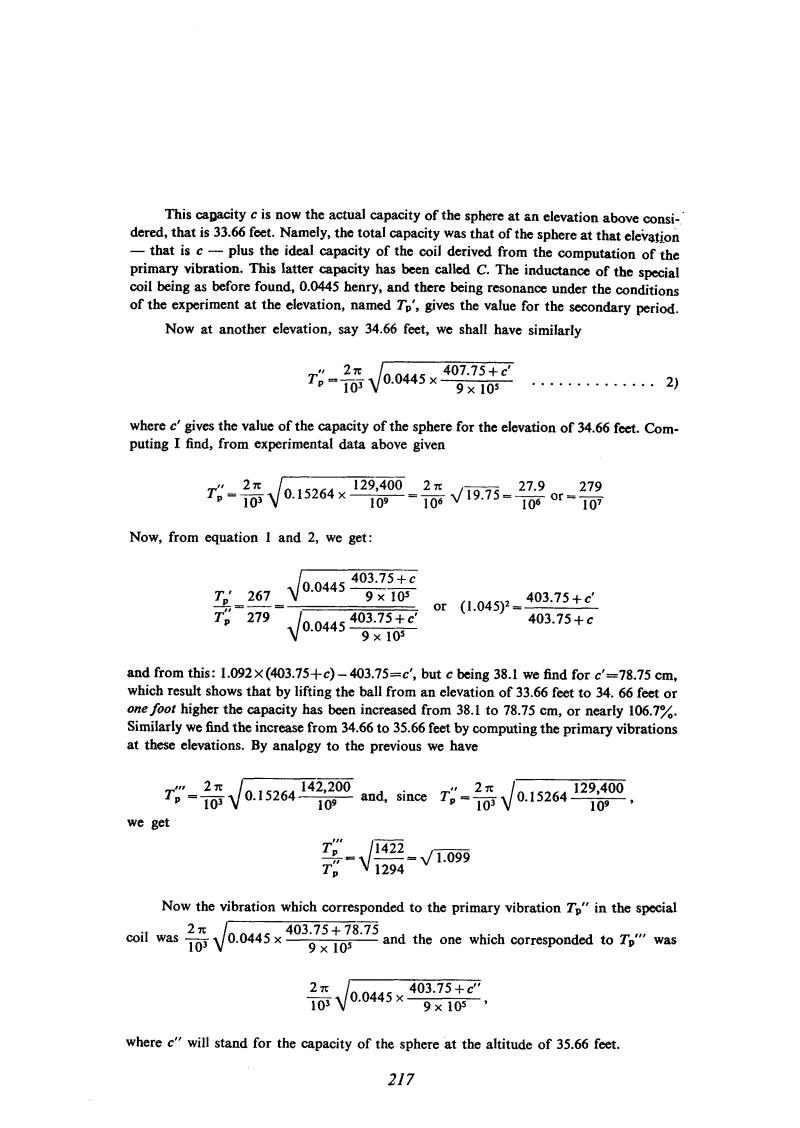
Nikola Tesla Books
This capacity c is now the actual capacity of the sphere at an elevation above considered, that is 33.66 feet. Namely, the total capacity was that of the sphere at that elevation - that is c - plus the ideal capacity of the coil derived from the computation of the primary vibration. This latter capacity has been called C. The inductance of the special coil being as before found, 0.0445 henry, and there being resonance under the conditions of the experiment at the elevation, named Tpâ, gives the value for the secondary period.
Now at another elevation, say 34.66 feet, we shall have similarly
$! {T_{p}'' = {{2 \pi \over 10^{3}} \sqrt{0.0445 \times {407.75 + c' \over {9 \times 10^{5}}}}}} $! . . . . . . . . . . 2)
where c' gives the value of the capacity of the sphere for the elevation of 34.66 feet. Computing I find, from experimental data above given
$! {T_{p}'' = {{2 \pi \over 10^{3}} \sqrt{0.15264 \times {129,400 \over 10^{9}}}} = {{2 \pi \over 10^{6}} \sqrt{19.75}} = {27.9 \over 10^{6}}} $! or = $! {279 \over 10^{7}} $!
Now, from equation 1 and 2, we get:
$! {{T_{p}' \over T_{p}''} = {267 \over 279} = {{\sqrt{0.0445 {403.75 + c \over {9 \times 10^{5}}}}} \over {\sqrt{0.0445 {403.75 + c' \over {9 \times 10^{5}}}}}}} $! or $! {{(1.045)^{2}} = {{403.75 + c'} \over {{403.75 + c}}}} $!
and from this: 1.092 x (403.75 + c) - 403.75 = c', but c being 38.1 we find for c' = 78.75 cm, which result shows that by lifting the ball from an elevation of 33.66 feet to 34.66 feet or one foot higher the capacity has been increased from 38.1 to 78.75 cm, or nearly 106.7%. Similarly we find the increase from 34.66 to 35.66 feet by computing the primary vibrations at these elevations. By analogy to the previous we have
$! {T_{p}''' = {{2 \pi \over 10^{3}} \sqrt{0.15264 {142.200 \over 10^{9}}}}} $! and, since $! {T_{p}'' = {{2 \pi \over 10^{3}} \sqrt{0.15264 {129,400 \over 10^{9}}}}} $!,
we get
$! {{T_{p}''' \over T_{p}''} = {\sqrt{{1422 \over 1294}}} = {\sqrt{1.099}}} $!
Now the vibration which corresponded to the primary vibration Tp'' in the special coil was $! {{2 \pi \over 10^{3}} \sqrt{0.0445 \times {{403.75 + 78.75} \over {9 \times 10^{5}}}}} $! and the one which corresponded to Tp''' was
$! {{2 \pi \over 10^{3}} \sqrt{0.0445 \times {{403.75 + c''} \over {9 \times 10^{5}}}}} $!,
where c'' will stand for the capacity of the sphere at the altitude of 35.66 feet.
217
October 9
He continues to improve the method for variable capacitance measurement of a sphere by varying the height. Last measurements he performed on Oct. 5, but he did not provide the calculated values.
After that he was improving the apparatus as a whole, and changed the "special coil" connection method. "Weaker Link", which was a main characteristic of the change, indicated immediately its good characteristics. Less excited "special coil" was easier to be adjusted in resonance, because there were no current streamers. The effect of parasitic capacitance was reduced to mainly distributed capacitance of the "special coil". Prior to the sphere capacitance variation measurement related to height variation, he determines the "special coil" distributed capacitance. He assumes that the circuit with a sphere resonates at frequency Ï0, which is defined by oscillator primary circuit so that it could be written: Lp1Cp = Lsc(c + C), where Lp1 and Cp are total inductance (with the regulating coil included) and primary oscillator circuit capacitance, respectively. Lsc is ''special coil'' inductance (with inductances connections included). C is distributed or parasitic capacitance of the "special coil", and c is the sphere capacitance. At some other height only the sphere capacitance is changed in the circuit of the "special coil". In order to achieve the resonance between the system and the signal from the oscillator, Tesla varies the inductance in the primary circuit. When the generator frequency is equal to the resonant frequency of "free coil" circuit, according to Tesla, the following equation could be written: Lp2Cp = Lsc(c' + C).
Division of this equation by the previous one results in: c' = Lp2(c + C) - C, which corresponds to Tesla's equation from which c' is determined. Due to a calculation error when C was calculated, Tesla's various results for the sphere capacitance are higher by approximately 10%, but this does not essentially change the main conclusions. When calculating the coil distributed capacitance* he uses the relation LpCp = Lsc(c + C) for the sphere at a height, where he considers that its capacitance is close to the theoretical value for the remote sphere.
When commenting on results, he mentioned that this assumption could be the cause of the error.
* Under the term coil distributed capacitance Tesla considers the total capacitance among coil turns. Here he uses another definition "internal capacitance", which is similar to the one which is normally used even today.

